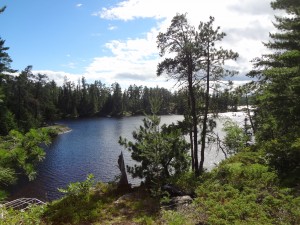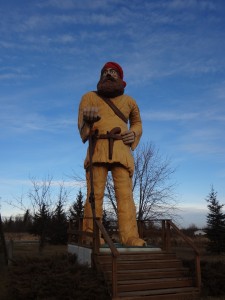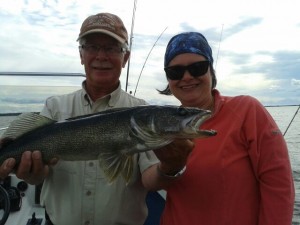The lay of the land: Researching a national park's administrative history
23 September 2013 – Joan Zenzen

Zenzen stayed on this island to learn about the Minnesota lake culture. Photo courtesy of Joan Zenzen.
I spent two weeks in July immersing myself in the life and feel of northern Minnesota, all in service of an administrative history I am writing of Voyageurs National Park. I consider such experiential learning as another primary source that I can call upon when writing. Public historians have the flexibility but also the challenge of identifying the needed resources for their topics. What types of sources do I find most useful when writing about the establishment, preservation, and management of national parks?
Taking a tour and watching other visitors interact with features in the park are my entry to investigating the history of a park. First, I need a sense of the geography so that when I write, I understand the lay of the land, beyond what I see on the park maps. Second, I need that visceral experience, that “ooh-ahh” that explains why people fought to have the park established. I need to feel that connection to the scenery and other features. Third, I want to see how others react to the park’s beauty and mystery. What grabs their attention? What do they comment upon? How do they move through the landscape? I am not taking an official survey of visitors, but I am watching, learning, and mentally noting visitor reactions versus my own.
I use oral histories to garner more insights into people and the parks. Administrative histories require examination of key management issues, so I usually interview any past superintendents to hear how they addressed these concerns. I balance this “company line” with interviews with local residents, area business leaders, elected officials, and others who may and may not support the park and its activities. These interviews have

Zenzen interviewed one of the locals who erected this statue of a voyageur as a protest to the park. Photo courtesy of Joan Zenzen.
helped me see opposing viewpoints, clarify the components of complicated scenarios, and enliven the storyline. For this Voyageurs project, I interviewed one person who repeatedly challenged the park’s existence, taking the Park Service to court over a period of three decades. I gained a valuable appreciation for what the park took away from the people born and raised in the area.
Government documents, merely by their volume and staidness, could strangle a history, sapping all of the good storytelling out of it. Oral histories certainly provide an antidote. But, I consider these government tomes a friendly challenge: what is hidden in the ponderous language and seemingly infinite number of tables that tells me what was really going on with the park? General Management Plans, and their predecessor Master Plans, disclose how well park managers “play” with their neighbors. Done in a vacuum, the park usually has trouble down the road; done in cooperation with local stakeholders, there is a chance for positive forward movement. Interpretive Prospectuses lay out the vision of the park’s educational programs and exhibits. My question when reviewing the IPs usually falls into the category of “what is missing?” Voyageurs National Park spends a lot of time talking about the French-Canadian fur traders for whom the park is named. Geology and natural resources are also an integral part of the story. Missing is the more recent history, such as the relatively late arrival of European settlers. This latter story would explain to visitors why they don’t see the towering white pines with six-foot diameters, lost in the early 20th century to rampant uncontrolled logging.
My final primary source is experiential learning. For other park histories, I have engaged with reenactors, talked to them about their roles and equipment, followed them around over the course of hours, and watched their interactions with visitors. I did not try to portray a Civil War or American Revolutionary War soldier for these other parks, but I did

Zenzen caught this 25-inch walleye while learning about Voyageurs National Park. Photo courtesy of Joan Zenzen.
delve into the intricacies of reenacting. For Voyageurs, I took the part of the northern Minnesotan, raised on the lakes and devoted to the lake culture. I spent one week on an island with 10 people (artists, writers, musicians), living in rustic buildings with electricity but no running water. I swam, I canoed, I picked blueberries, I listened to the loons at dusk, I sat and watched the water ripple, I tried to imagine how so many Northlanders lived in their own little summer cabins on the water. These were the people who had to sell their cabins to make way in 1975 for the national park. The next week, I went out in a fast motorboat on Rainy Lake and toured the sites, caught walleye, ate that walleye at the historic hotel in the park, and had a great time out on the water. Vacation or public history research? It’s all part of collecting the primary sources for writing about national parks.
~ Joan Zenzen is an independent public historian based in Rockville, Maryland. She has written administrative histories of Fredericksburg and Spotsylvania National Military Park, Manassas National Battlefield Park (published by Penn State Press), Minute Man National Historical Park, and Fort Stanwix National Military Park (published by State University of New York [SUNY] Press).




Nice summary of the key elements needed in addressing both the intellectual/management issues of protected heritage areas and the critically important visceral feelings and beliefs that accompany exposure to these valued places. Thanks Joan.
Thanks, Dave. I think that this dual approach also helps to remind us public historians of the reasons why people fought to preserve these spaces/buildings in the first place. So much energy and commitment goes into the establishment of parks, and I think we need to capture that motivation while writing about the history.
Voyageurs is a great park. I wanted to bid on this history project but the timing was bad. I am glad it went to someone who will do a great job. Your comments about the summer home owners who lost their property brings up a management challenge that has hurt community relations at most of the Great Lakes region parks. Did you do any oral histories or informant interviews with any of them. I think it is important to consider what they lost to give us park vistors the resource we enjoy today.
Ted, yes, I did do some interviews with former land owners and business owners. The documentation from the period of park establishment is rife with confusion, anxiety, distrust, and outright hate towards the national park. I have tried to get some of those people most critical of the park from its establishment onwards to talk, but they have declined my offer. So the hearing transcripts and letters have become most important for capturing this general feeling.